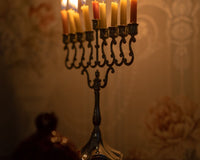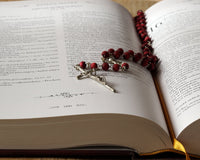The Messianic prayer shawl, also known as a tallit or tallis, is a traditional garment that is worn by followers of Messianic Judaism during prayer and other religious ceremonies. Messianic Judaism is a movement that combines elements of Judaism and Christianity, and the prayer shawl is an important symbol in this tradition.
The origins of the Messianic prayer shawl can be traced back to the Bible, specifically to the book of Numbers. In this book, God commands the Israelites to attach fringes, or tzitzit, to the corners of their garments as a reminder of God's commandments. These fringes were to be made of blue thread, a symbol of the blue sky and the heavens, and were to be worn as a reminder to keep God's commandments and to live a righteous life.
The use of prayer shawls in Messianic Judaism is rooted in both Jewish and Christian traditions. They are worn as a symbol of devotion and commitment to God, and as a reminder of the connection between the Jewish people and God. The shawl is typically made of wool or silk and is decorated with fringes on each of its four corners.
One of the main differences between traditional Jewish prayer shawls and Messianic prayer shawls is the inclusion of Christian symbols and imagery. These symbols often include the Star of David, which is a symbol of the Jewish people and their connection to God, as well as the fish, which is a symbol of Jesus and his followers. Some Messianic prayer shawls may also include the Hebrew name of Jesus or verses from the New Testament.
The inclusion of Christian symbols and imagery on the prayer shawl reflects the beliefs of Messianic Judaism that Jesus is the Messiah and that the New Testament is an extension of the Old Testament. This belief is rooted in the understanding that Jesus is the fulfillment of the Jewish prophecies and that he came to bring salvation to both Jews and Gentiles.
Messianic prayer shawls are also worn during specific religious ceremonies that are unique to Messianic Judaism. One such ceremony is the Passover Seder, which is a reenactment of the Jewish people's liberation from slavery in Egypt. During the Seder, the prayer shawl is worn as a symbol of freedom and salvation, with the tassels on the corners representing the commandments of God.
Another important ceremony in which the Messianic prayer shawl is worn is the Shabbat service. The Shabbat is the Jewish Sabbath, which is observed every Saturday, and it is a time of rest and worship. During the Shabbat service, the prayer shawl is worn as a symbol of the connection between God and the Jewish people, and as a reminder of the importance of keeping the Sabbath holy.
The Messianic prayer shawl is also worn during other religious festivals such as Hanukkah and Sukkot. Hanukkah is a Jewish festival that commemorates the miracle of the oil in the Temple and Sukkot is a Jewish festival that celebrates the harvest and the protective shelter of God. During these festivals, the prayer shawl is worn as a symbol of God's protection and provision.
In addition to their religious significance, Messianic prayer shawls are also considered to be works of art. Many Messianic prayer shawls are hand-woven and decorated with intricate designs and patterns. Some shawls are even embroidered with verses from the Torah or other religious texts. The making of Messianic prayer shawls is considered a sacred act, and many Messianic Jewish families have passed down the tradition of making prayer shawls for generations.
Shop our full collection of Messianic Prayer Shawls here.






